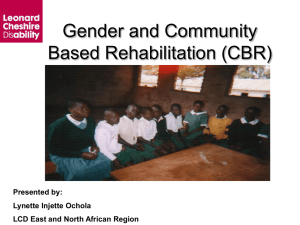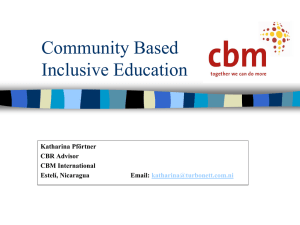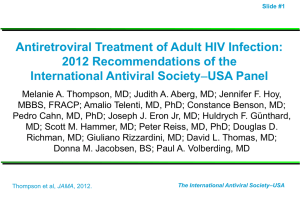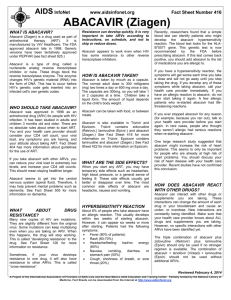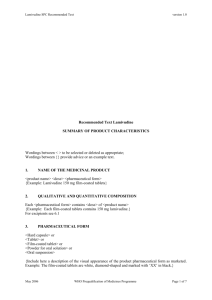CD4 count > 500/µL - The JAMA Network Journals
advertisement
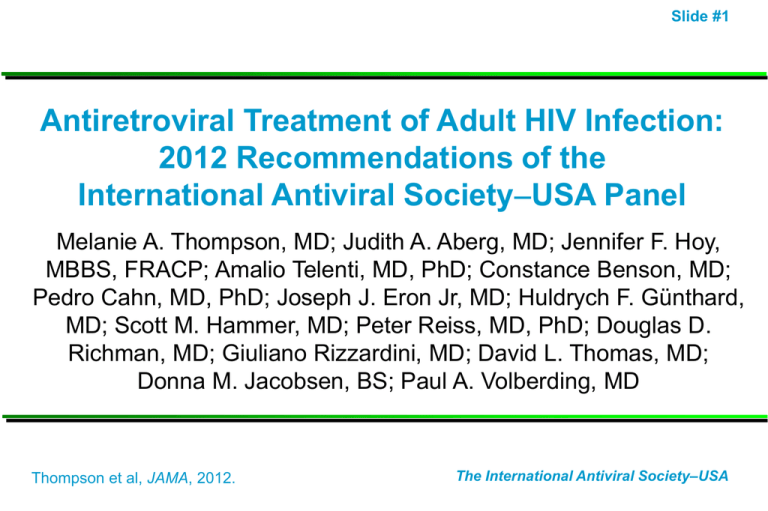
Slide #1 Antiretroviral Treatment of Adult HIV Infection: 2012 Recommendations of the International Antiviral SocietyUSA Panel Melanie A. Thompson, MD; Judith A. Aberg, MD; Jennifer F. Hoy, MBBS, FRACP; Amalio Telenti, MD, PhD; Constance Benson, MD; Pedro Cahn, MD, PhD; Joseph J. Eron Jr, MD; Huldrych F. Günthard, MD; Scott M. Hammer, MD; Peter Reiss, MD, PhD; Douglas D. Richman, MD; Giuliano Rizzardini, MD; David L. Thomas, MD; Donna M. Jacobsen, BS; Paul A. Volberding, MD Thompson et al, JAMA, 2012. The International Antiviral Society–USA Slide #2 IASUSA Antiretroviral Guidelines 1996 – 2012 Slide #3 IASUSA Antiretroviral Guidelines • Authored by 15-member, international (6 countries) panel – Members receive no compensation and agree not to participate in industry promotional activities while on the panel • Evidence-based guidelines are developed by consensus and based upon pathogenesis research, well-designed clinical trials, and large observational cohorts • Rated on strength of recommendations and quality of evidence • Primarily for clinicians in highly resourced settings; however, principles are universally applicable Thompson et al, JAMA, 2012. Slide #4 Methods • Systematic literature review of PubMed and EMBASE for data published or presented 7/10 – 5/12 • Hand searches for newly published reports and scientific abstracts, safety reports • Product efficacy or safety data from ARV manufacturers were reviewed to assure completeness • Data not published or presented in a peer-reviewed setting were not considered, except safety reports Thompson et al, JAMA, 2012. Slide #5 When to Start Antiretroviral Therapy Slide #6 Antiretroviral therapy (ART) is recommended and should be offered to all persons with HIV regardless of CD4 cell count. Slide #7 Potential Risks and Benefits of Earlier ART Initiation Potential Benefits Prevention of progressive immune destruction (AIDS) and improved survival Decreased immune activation, inflammation, and serious nonAIDS diseases Decreased drug resistance Decreased risk for some ARV toxicities Decreased HIV transmission Potential Risks ARV toxicity – short and long term If adherence is suboptimal, risk of resistance and transmission of resistant virus Resistance may limit future choices of ART Slide #8 Rationale for Recommending ART for All HIV-Infected Adults • Uncontrolled HIV replication, immune activation and inflammation associated with serious ‘non-AIDS’ illnesses even at CD4 counts > 500/µL – Cardiovascular, hepatic, renal, neurologic, malignancies – High CD4 counts and suppressed virus are associated with decreased disease incidence • Newer therapies are more potent, less toxic, more tolerable, and simpler to take leading to improved patient adherence and regimen durability • ART decreases HIV transmission Thompson et al, JAMA, 2012. Slide #9 Earlier ART Associated with Decreased Mortality and Disease Progression: Observational Studies Study Published N Endpoint Relative Hazard P or 95% CI NA-ACCORD NEJM, 2009 8,362 Death 1.69 CD4 <350 vs 350-500 < 0.001 NA-ACCORD NEJM, 2009 9,155 Death 1.94 CD4 <500 vs > 500 < 0.001 When to Start Consortium Lancet, 2009 24,444 AIDS or Death 1.28 CD4 251-350 vs 351-400 1.04–1.57 HIV-CAUSAL Ann Int Med, 2011 20,971 AIDS or Death 1.38 CD4 <350 vs <500 1.23-1.56 CASCADE Arch Int Med, 2011 9,455 Death 0.51 (HR)* CD4 350-499 vs deferred 0.33-0.80 COHERE Plos Med, 2012 75,336 AIDS or Death 0.74 (HR)* CD4 350-<500 on ART 0.96 (HR)* CD4 > 500 on ART 0.58-0.80 1.54 CD4<200 vs <500 0.33-0.87 ATHENA AIDS, 2012 3,068 Death, AIDS, Non-AIDS 0.92-0.99 HPTN 052: ART Treatment Reduces HIV-1 Transmission Total HIV-1 Transmission Events: 39 Immediate Arm 4 96% Reduction with Early ART Delayed Arm 35 p < 0.0001 Cohen, NEJM 2011; 365:492-505 When to Start ART: IAS–USA Recommendations 2012 Slide #11 • Patient readiness should be considered when deciding to initiate ART • ART is recommended and should be offered regardless of CD4 cell count • The strength of the recommendation and quality of the evidence increases as CD4 count decreases and in the presence of certain conditions When to Start ART: IAS–USA Recommendations 2012 Slide #12 • Strength of recommendation and quality of evidence varies – According to CD4 cell count • CD4 < 500 cells/µL (AIa) • CD4 > 500 cells/µL (BIII) – According to clinical condition • Pregnancy (AIa) • Chronic HBV (AIIa) • HCV (may delay until after HCV treatment if CD4 > 500) (CIII) • Age older than 60 years (BIIa) • HIV-associated nephropathy (AIIa) • Acute phase of primary HIV infection, regardless of symptoms (BIII) Initiation of Antiretroviral Therapy in HIV-Infected Adults Criteria IAS-USA 2012 DHHS 2012 CD4 count <350/µL CD4 count 350500/µL Treat Treat CD4 count > 500/µL EACS 2011 Slide #13 WHO 2010 Treat Treat Asymptomatic: Consider Symptomatic: Treat Stage 3 or 4 Symptomatic: Treat Stage 3 or 4 Pregnancy Treat Treat Treat < 350/µL;Stage 3-4 History AIDSdefining Illness Treat Treat Treat Treat HIV-assoc Nephropathy Treat Treat Treat Not specified HBC Coinfection Treat Treat Treat, if HBV tx indicated Treat, if HBV tx indicated HCV Coinfection Treat; Consider treating HCV first if CD4 > 500/µL Treat; Consider Treat if CD4< treating HCV first 500/µL; Defer if CD4 > 500/µL /consider CD4 >500/µL Not specified Age > 60 years Treat Not specified Not specified Not specified Slide #14 Other Important New Recommendations • Early ART initiation when opportunistic infections are present, except cryptococcal meningitis and TB meningitis, where expert consultation is required • When and how to use existing, new, and emerging therapies • Monitoring for entry into and retention in care, ART adherence, and quality indicators • Consideration of PrEP Slide #15 Path to an “AIDS-free Generation” • Early diagnosis through increased testing Slide #16 • Prevention education, condoms, and consideration of PrEP for high-risk HIV uninfected individuals • Monitor and enhance entry into care and retention in care • Universal access to ART, for individual and societal benefit • Monitor and support ART adherence • Continued efforts at the highest levels to decrease social determinants of health, including stigma • Continued research on new strategies for treatment, prevention, and cure • Activism to encourage the political will to fully fund evidence-based prevention and treatment interventions Slide #17 Backup Slides Slide #18 Choice of Initial Regimen Tenofovir/emtricitabine (TDF/FTC) OR Abacavir/lamivudine (ABC/3TC) HLA B*5701 negative HIV-1 RNA <100,000 c/mL WITH Third agent (NNRTI, boosted PI, or InSTI): • Efavirenz OR • Atazanavir/r OR • Darunavir/r OR • Raltegravir Thompson et al, JAMA, 2012. Slide #19 Alternative Initial Antiretroviral Regimens* Component Alternative Regimens NNRTI plus nRTIs • Nevirapine plus tenofovir/emtricitabine or abacavir/lamivudine (BIa) • Rilpivirine/tenofovir/emtricitabine (or rilpivirine plus abacavir/lamivudine) (BIa) Comment • Severe hepatotoxicity and rash with nevirapine more common in initial therapy when CD4 cell count is >250/µL in women and >400/µL in men Thompson et al, JAMA, 2012. Slide #20 Alternative Initial Antiretroviral Regimens* Component Alternative Regimens PI/r plus nRTIs • Darunavir/r plus abacavir/lamivudine (BIII) • Lopinavir/r plus tenofovir/emtricitabine (BIa) (or abacavir/lamivudine) (BIa) Comment • Other alternative PIs include fosamprenavir/r and saquinavir/r but indications to use these options for initial treatment are rare. Thompson et al, JAMA, 2012. Slide #21 Alternative Initial Antiretroviral Regimens* Component Alternative Regimens InSTI plus nRTIs • Raltegravir plus abacavir/lamivudine (BIIa) • Elvitegravir/cobicistat/tenofovir/emtricita bine** (BIb) Comment • Raltegravir is given twice daily; experience with elvitegravir/cobicistat/tenofovir/emtricita bine is limited to 48-week data. * Submitted for regulatory approval Thompson et al, JAMA, 2012. Slide #22 CCR5 AntagonistBased and nRTI-Sparing Initial Regimens in Special Circumstances Only Component CCR5 antagonist plus nRTIs, (NNRTI-, PI-, and InSTI-sparing) Regimens • Maraviroc plus tenofovir/emtricitabine or abacavir/lamivudine (CIII) PI/r plus InSTI (nRTIsparing) • Darunavir/r plus raltegravir (BIIa) • Lopinavir/r plus raltegravir (BIa) * See comments Thompson et al, JAMA, 2012.





